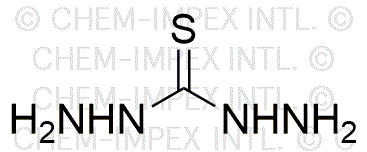Thiocarbohydrazide is widely utilized in research focused on:
- Analytical Chemistry: It serves as a reagent in various analytical methods, particularly for the detection of heavy metals and transition metals in environmental samples.
- Pharmaceutical Development: This compound is used in the synthesis of pharmaceuticals, especially in the creation of anti-tuberculosis agents, highlighting its importance in medicinal chemistry.
- Polymer Industry: Thiocarbohydrazide acts as a curing agent for resins and polymers, enhancing their mechanical properties and thermal stability, which is crucial for manufacturing durable materials.
- Biochemistry: It is employed in biological assays to study enzyme activity and protein interactions, making it valuable for researchers in the life sciences.
- Corrosion Inhibition: The compound is used in formulations to prevent metal corrosion, particularly in industrial applications, providing a cost-effective solution to maintain equipment longevity.
General Information
Properties
Safety and Regulations
Applications
Thiocarbohydrazide is widely utilized in research focused on:
- Analytical Chemistry: It serves as a reagent in various analytical methods, particularly for the detection of heavy metals and transition metals in environmental samples.
- Pharmaceutical Development: This compound is used in the synthesis of pharmaceuticals, especially in the creation of anti-tuberculosis agents, highlighting its importance in medicinal chemistry.
- Polymer Industry: Thiocarbohydrazide acts as a curing agent for resins and polymers, enhancing their mechanical properties and thermal stability, which is crucial for manufacturing durable materials.
- Biochemistry: It is employed in biological assays to study enzyme activity and protein interactions, making it valuable for researchers in the life sciences.
- Corrosion Inhibition: The compound is used in formulations to prevent metal corrosion, particularly in industrial applications, providing a cost-effective solution to maintain equipment longevity.
Documents
Safety Data Sheets (SDS)
The SDS provides comprehensive safety information on handling, storage, and disposal of the product.
Product Specification (PS)
The PS provides a comprehensive breakdown of the product’s properties, including chemical composition, physical state, purity, and storage requirements. It also details acceptable quality ranges and the product's intended applications.
Certificates of Analysis (COA)
Search for Certificates of Analysis (COA) by entering the products Lot Number. Lot and Batch Numbers can be found on a product’s label following the words ‘Lot’ or ‘Batch’.
*Catalog Number
*Lot Number
Certificates Of Origin (COO)
This COO confirms the country where the product was manufactured, and also details the materials and components used in it and whether it is derived from natural, synthetic, or other specific sources. This certificate may be required for customs, trade, and regulatory compliance.
*Catalog Number
*Lot Number
Safety Data Sheets (SDS)
The SDS provides comprehensive safety information on handling, storage, and disposal of the product.
DownloadProduct Specification (PS)
The PS provides a comprehensive breakdown of the product’s properties, including chemical composition, physical state, purity, and storage requirements. It also details acceptable quality ranges and the product's intended applications.
DownloadCertificates of Analysis (COA)
Search for Certificates of Analysis (COA) by entering the products Lot Number. Lot and Batch Numbers can be found on a product’s label following the words ‘Lot’ or ‘Batch’.
*Catalog Number
*Lot Number
Certificates Of Origin (COO)
This COO confirms the country where the product was manufactured, and also details the materials and components used in it and whether it is derived from natural, synthetic, or other specific sources. This certificate may be required for customs, trade, and regulatory compliance.

